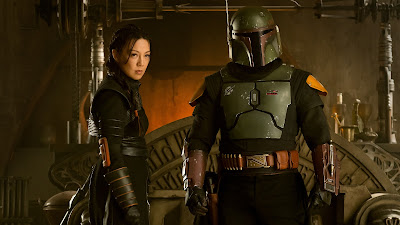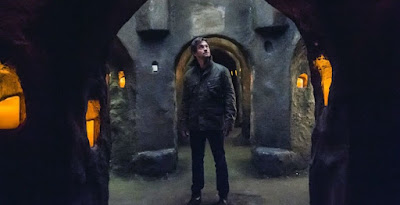TV REVIEW: 'The Book of Boba Fett' - Episodes 1-4
The following contains mild spoilers for the first four episodes of “The Book of Boba Fett”
Following his gloriously ultraviolent re-entry into the Star Wars universe in the Disney+ original series “The Mandalorian,” the iconic bounty-hunter-turned-crime-lord, Boba Fett has now returned to the small screen in his own series entitled “The Book of Boba Fett.” With a new mission at hand rather than hunting down enemies of the Empire, the ex-mercenary (played by Temuera Morrison) emerges from the grave as he finds himself taking up the reins of the criminal underworld once ruled by the crime lord Jabba the Hutt. Now with enemies of his own taking aim at his throne, Fett must carve a journey of desperate survival and renewed opportunity in order to reclaim – and reinvent – who he is. As the first four episodes of the seven-episode series shows us, war is mounting on Fett’s doorstep, set to test his skills not only as a once-feared warrior but also as a respected leader.
Acting as a spin-off of the Jon Favreau-created series “The Mandalorian,” the continued adventures of the helmeted gun-for-hire Boba Fett (who we last saw plummet to this demise in 1983’s “Return of the Jedi”) admittedly adopts many of its aesthetic and narrative inspirations from the previous Disney+ hit. A space western following the exploits of a faceless bounty hunter out to reclaim his past, the parallels between the two series are laid out on its sleeve. Despite sharing the look and feel of the other show, however, “The Book of Boba Fett” quickly works to step out of the shadow of “The Mandalorian” (at least for now) as it chronicles the return of one of the galaxy’s most notable baddies. While the premiere of the new series might kick things off in a less explosive fashion than expected, the episodes that follow lay the emotional groundwork for Fett’s journey towards where we see him at the conclusion of season two of “The Mandalorian.”
After a brief stint on the other aforementioned Star Wars series where he teamed with Ming-Na Wen’s Fennec Shand (who returns at the bounty hunter’s side in the new series) and plowed through an army of Stormtroopers armed only with a gaffi stick, Fett finds himself in a new and delicate seat of power beyond anything that he has ever known. As a former bounty hunter tasked with rounding up targets across the galaxy and delivering justice, he is out of his element in a world of diplomacy and order. You can see Fett’s uneasiness in Morrison’s dry but contemplative performance. He is confident in the role he wants to attain beyond being a hired gun, but he is unsure how to gain the respect of his people outside of the violence he knows. Morrison’s performance also perfectly captures the character’s pain, involving not only his upbringing and the death of his father, Jango, but also the trials he faces following his escape from the sarlacc pit.
When we find Fett in this series he is not only working through some trauma after falling to his supposed demise, but also working to reestablish his image in the galaxy. Beaten down and stripped of his iconic armor in the premiere episode, we first see him captured by a tribe of Tusken Raiders, the nomadic inhabitants of the desert planet of Tatooine. Despite his fractured mental state and his lack of armor, however, Fett is able to quickly earn the respect of the tribe by saving the life of one of their younger members. Forming a kinship with the Tuskens, Fett begins to realize that he isn’t going to get very far in gaining power without a tribe of his own at his side. This is reflected in his present-day exploits, which sees Fett usurping Jabba the Hutt’s palace by executing Jabba’s successor Bib Fortuna. The first four episodes of the series hop between Fett’s time with the Tuskens and his rise to power in the town of Mos Espa, showcasing just how the former bounty hunter is building up his posse while figuring out just what kind of leader he wants to be.
While Fett’s time with the Tuskens in the past is ultimately cut short (just as he joins their ranks and begins to relinquish his identity as a bounty hunter), he unearths the plot of a local crime syndicate, the Pykes, which spurs trouble not only for Fett in the past but also during his time as the new daimyo of Mos Espa. Juggling not only the growing presence of the Pykes on the planet, but also a slew of enemies and allies from a retro speeder gang of cyborgs to a hulking Wookiee mercenary, Fett’s transition to power becomes increasingly more complicated than he realizes. As the show devotes much of its time to Fett’s exploits outside of his armor, the events of his past with the Tuskens are slowly giving insight into how Fett operates in his new landscape as a crime lord.
Where Boba Fett’s story goes from here, as a war mounts between his new “tribe” and the Pykes, remains somewhat unclear. Despite the flashbacks the series is using to unspool Fett’s emotional and physical journey up to this point, the character’s progress in the present still feels incomplete. Yes, while we do still have three episodes left before the series concludes, one of my biggest questions is how Fett’s character will ultimately change as he slowly relinquishes his days as a bounty hunter to become a more noble and benevolent figurehead of his own empire. The lessons being offered to Fett through his experiences with the Tuskens and his kinships with Shand and other characters are significant to the story, but there remains a missing layer of resonance in Fett’s character and his motivations. Just as we will see the action of the series begin to come to a head in the following episodes, hopefully we will see its main character go through some meaningful catharsis about who he is.





Comments
Post a Comment